St Peter's, (See below) Holy Trinity & All Saints
They are of very ancient foundation being as old as the introduction of Christianity in the Kingdom of the West Saxons in the 7th Century. Further more detailed background is freely available from the book 'The History of Dorchester' by James Savage which was published in 1837. A full transcription can be viewed at google books. Most of the text given below however has been transcribed from John Hutchins book 'The History and Antiquities of the County of Dorset'. I have taken the liberty of adding some pictures which relate to the text and cross referencing to other information on this site.
Though St Peter's is the largest and the principal church in the town, it is only a chapel to Holy Trinity church, and has been since 1303, and perhaps even before that; yet there are two instances in the Sarum Registers when the king presented this as a distinct Rectory. From the municipal records of Dorchester in 1657, and a legal case that arose in 1826, it is clear that the two churches were united and this for example was why the Rev. John White was appointed by the King to Holy Trinity in 1606 but often preached from the pulpit and, was eventually buried in the south porch of St Peters church in 1648. Michael Russell OPC for Dorchester
The History and Antiquities of the County of Dorset
(3rd Edition published 1868 - pages 334 to 409)
by John Hutchins -- Pages 379-389
Part 24
(3rd Edition published 1868)
Transcribed by Michael Russell OPC for Dorchester - October 2016
St Peter's Church
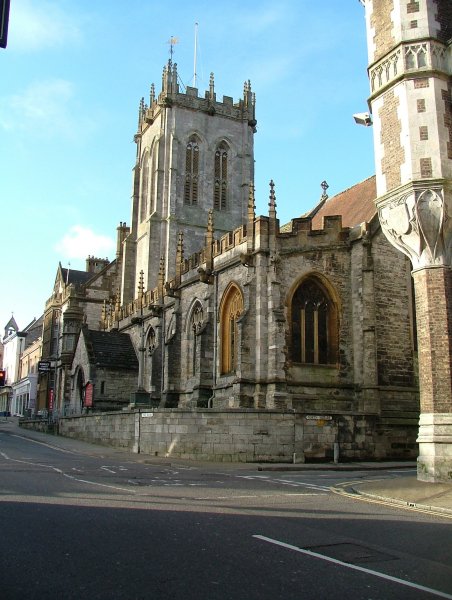
The Parish of St Peter's is a distinct and independent one, has its own parish officers, maintains its own poor, and repairs its own church. It composes the middle part of town, and contains part of East Street, from the western bounds of All Saints' Parish to the church of Holy Trinity, and the houses lately built on the site of the old 'Crown Inn', opposite to it; also the South Street; a little square called 'Bull Stake'; the north part of Priory Lane and the Priory.
Saint PETERS CHURCH stands in the centre of the town, at the higher end of the Corn Market. It is large, ancient, and well built, consisting of a chancel, body, and chancel. The north aisle is plain, its east end raised considerably higher than the rest, and embattled; and was built or rebuilt by some of the family of 'WILLIAMS' of Herringstone whose burial place is there. The south aisle is embattled, and its east end also raised. The east ends of both aisles were probably chapels or chantries. The body is compass-roofed supported by five pillars but has no windows over the arches. The tower is very neat adorned with pinnacles and battlements and is 90 feet high. There were formerly five bells which in 1734 were re-cast and augmented to eight, chiefly at the expense of the representatives [of the borough]. Here is a clock and chimes. The whole fabric is tiled.
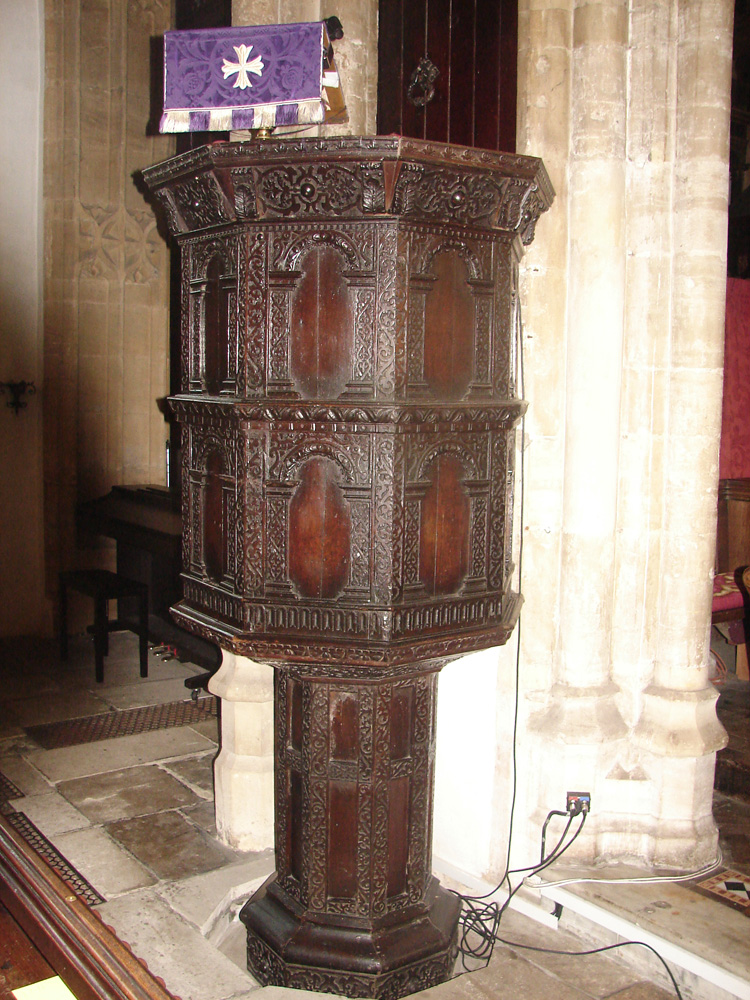 This church is one of the principal architectural ornaments of the High street of Dorchester. It stands on the north side of the street, nearly opposite the end od South street; and besides the parts mentioned above by Hutchins
has a south porch and an organ chapel, which later was added when the edifice was restored and some portions rebuilt in 1857. The aisles are about 46ft in length by 43 ft in width, the chancel about 23½ft in length by 19½ft in width. The work done at this date comprised the rebuilding of the east end in a style in accordance with the other characteristics of the edifice. A gallery which formerly spanned the west end of the nave was taken down, and the organ, which stood under the tower arch, was removed to a chapel on the north side of the north chancel aisle, built for its reception at the expense of Herbert and Robert WILLIAMS Esq'rs. This organ is a fine instrument by Bishop, was erected in 1824. A new roof was placed upon the chancel, and the church was newly floored and furnished with appropriate fittings, including a handsome reading desk and lectern, carved in old oak. A reredos of Caen stone, consisting of a succession of panels in carved and sunk work, was erected under the east window of the chancel. The arcades of the nave are composed of four pointed arches on each side, of uniform design. The pillars have an attached shaft on each cardinal face with a moulded space between, and the shafts have circular capitals with octagonal bases and plinths. The arch between the nave and chancel is of similar character. The arch at the west end of the nave into the tower
has also attached shafts with capitals and bases, and a bold wave moulding and fillets between. All the arches are about the same date, namely the early part of the fifteenth century. The side chapels of the chance are connected both with the chancel and aisles by wide and lofty pointed arches, which have the soffits paneled like those of the nave of Sherborne abbey, and are of the latter part of the fifteenth century. In the south pier of one of these arches
opening into the north aisle are the remains of the stairs to the rood-loft, a doorway having been formed in the paneling. This was subsequently adopted as the approach to the pulpit, which is a good example of Jacobean character, standing in the nave close to the north side of the chancel arch (picture right taken by myself 2012)
This church is one of the principal architectural ornaments of the High street of Dorchester. It stands on the north side of the street, nearly opposite the end od South street; and besides the parts mentioned above by Hutchins
has a south porch and an organ chapel, which later was added when the edifice was restored and some portions rebuilt in 1857. The aisles are about 46ft in length by 43 ft in width, the chancel about 23½ft in length by 19½ft in width. The work done at this date comprised the rebuilding of the east end in a style in accordance with the other characteristics of the edifice. A gallery which formerly spanned the west end of the nave was taken down, and the organ, which stood under the tower arch, was removed to a chapel on the north side of the north chancel aisle, built for its reception at the expense of Herbert and Robert WILLIAMS Esq'rs. This organ is a fine instrument by Bishop, was erected in 1824. A new roof was placed upon the chancel, and the church was newly floored and furnished with appropriate fittings, including a handsome reading desk and lectern, carved in old oak. A reredos of Caen stone, consisting of a succession of panels in carved and sunk work, was erected under the east window of the chancel. The arcades of the nave are composed of four pointed arches on each side, of uniform design. The pillars have an attached shaft on each cardinal face with a moulded space between, and the shafts have circular capitals with octagonal bases and plinths. The arch between the nave and chancel is of similar character. The arch at the west end of the nave into the tower
has also attached shafts with capitals and bases, and a bold wave moulding and fillets between. All the arches are about the same date, namely the early part of the fifteenth century. The side chapels of the chance are connected both with the chancel and aisles by wide and lofty pointed arches, which have the soffits paneled like those of the nave of Sherborne abbey, and are of the latter part of the fifteenth century. In the south pier of one of these arches
opening into the north aisle are the remains of the stairs to the rood-loft, a doorway having been formed in the paneling. This was subsequently adopted as the approach to the pulpit, which is a good example of Jacobean character, standing in the nave close to the north side of the chancel arch (picture right taken by myself 2012)The east window of the chancel has five lights and is of modern construction, but corresponds in character with the ancient work. It is filled with stained glass, and a brass plate in the cill bears the inscription:
This window was erected AD MDCCCLVI (i.e. 1856) to the memory of Thomas COOMBS of this town who died xiiith May MDCCCLII (i.e. 13th May 1852) aged lxxv (i.e. 75) by Emma his wife who died iind Novr MDCCCIXI (i.e. 2nd Nov 1861) aged IXIV (i.e. 64) In remembrance of whom this tablet is placed here by their affectionate children [Note:- Link to more information about Thomas COOMBS(1777-1852) Attorney of Dorchester. Tablet erected by his surviving children Henrietta and Arthur Coombs]
The old east end had a projecting window of a debased style, which was surmounted by an ugly elliptical window of wood.
The windows of the aisles and chapels are of three lights, with cinquefoil heads, with trefoil abatement lights and quatrefoil at the apex, under a pointed arch.
The south door under the porch is a curious example of Transition-Norman, the arch pointed and richly ornamented with mouldings of a purely Norman character. The jambs are champhered, and the arch-mouldings stopped by small carved brackets of Early-English character.
The roof of the nave is of a form very commonly occurring in this country. It is cylindrical with arched and horizontal ribs, dividing the surface of the vault into panels. Carved bosses ornament the intersections. The compartments are now plastered, covering the carved rafters which were probably shown when first constructed.
Exteriorly the aisles have buttresses with two moulded sets off and small pinnacles, between the windows; at the angles are double buttresses. The parapets are embattled, with the moulding continued round the embrasures, and below the string-course of the parapet, and over each buttress are boldly carved gargoyles, grotesques representations of birds and animals.
The Tower is 90ft in height and 15ft square; it has clustered pinnacles, embattled parapet, &c. The west door has a pointed arch with good mouldings, and over this a large three-light window, with transom and cinquefoil heads to the lights above and below.
The Bells bear the following inscriptions:
-
1. Mr Daniel ARDEN, Mr Joseph GIGGER, ch: [i.e. church] wardens. Mr Renaldo KNAPTON saw me cast ye 21 Sep 1734 [Note:- Link provided to more information about Daniel ARDEN, Also to Joseph Gigger (Junior) (1704-1740). Renaldo KNAPTON was elected as a Capital Burgess of Dorchester 13th May 1726 when his father died and an Alderman of Dorchester on 1st Oct 1733]
2.Sr Wm CHAPPEL Kt and John BROWN esqr memr of Parliament, gave a 105 pounds to thes Bells. The Revd Docr LEIGH D.D., Docr ARCHER MD., The Revd John NELSON, Jos. SEWARD, gent, Mr George Cooper MARDEN, Mr GIGGER, church warden. T.B.
3. Mr Daniel ARDEN, and Mr Joseph GIGGER, church wardens 1734, God send ys good Loc. T.B.F.
4. Mr Daniel ARDEN,and Mr Joseph GIGGER, church wardens 1734,George RICHARDS, esq, Mr Renaldo KNAPTON, Mr Thomas LODER, Mr Thomas COOPER, Mr Wm BRYER. Bilbie fecit
5. Mr Daniel ARDEN, and Mr Joseph GIGGER, church wardens 1734,
6. The gift of Robert BROWN Esqr Altho: my sound it is but small, will br heard among you all. Mr Daniel ARDEN, and Mr Joseph GIGGER, church wardens 1734,
7. This bell was re-cast in the year 1803. George FRAMPTON and John COOPER Churchwardens. T. Bilbie, Collumpton, fecit,
8. Mr John KING and Mr Thomas JONES churchwardens 1750. T. Bilbie fecit.
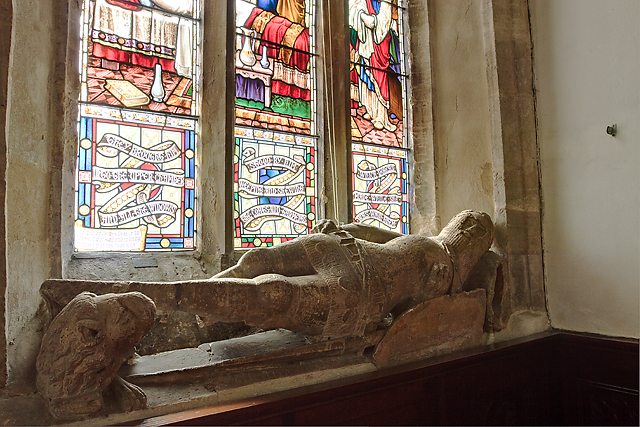
(1) Effigy of a medieval knight - St Peter's church, Dorchester
© Copyright Mike Searle and licensed for reuse under this Creative Commons Licence
There are two fine monumental effigies in this church, engravings of which appear [above]. After speaking of the north aisle, Hutchins says, "Below in the fourth window of the aisle, lies on a stone coffin the effigy of a man cross-legged, completely armed in a coat of mail and helmet which covers the greater part of the face, and resembles those which Speed, in his chronicle, represents on the seals of Henry II and Richard I. He has a belt, spurs, sword, and shield, on which last are no arms. His head rests on a cushion, his feet on a lion or a dog. If this represents a crusader who either vowed or actually made an expedition to the Holy Land, it must be ancient. The first crusade was published by Pope Urban II. at the Council of Clermont in Auvergne, 1095. Ptolemais was taken by the Sultan of Egypt 1291, with which ended the Holy War.
"In the south window is another effigy in all respects like the former. Mr COKER says that the monuments in the windows of this church belonged to the Chidiocks, founders of the priory, and were removed with others hither as he had heard, when the priory church was pulled down. That these effigys are cross-legged, is no objection to their representing some of the Chidiock family, whose pedigree, given before p 257, goes back to the beginning of the reign of Edward I. One of these figures is said by tradition to be founder of the church, and vulgarly called Geffery VANN, or rather ANN, for about 1680 was dug up in a garden in this town a seal, and round it 'Sigillum Galfridi de Ann'. It was in the possession of the late Colonel Michel A family of this name was anciently seated at Winterbourne-Faringdon.
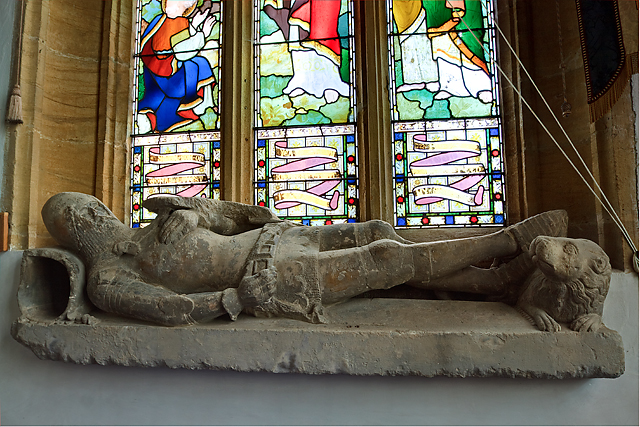
(2) Effigy of a medieval knight - St Peter's church, Dorchester
© Copyright Mike Searle and licensed for reuse under this Creative Commons Licence
As will be seen by the succeeding description, this account of our author's includes many serious errors. The monuments are not in the same position as when he wrote, but the tombs on which they originally rested were probably destroyed before his time. There is a tradition that the effigies have been removed from some other locality, but it is unknown whether it rests upon any authority of value. The figures resemble each other in almost every respect, the difference between them consisting only of a few trifling details. They are both executed in stone, are cross-legged, the armour of plate, with the usual exception of the mail gorget or camail and gussets. The helmets or basinets are conical, and the features strongly marked. The heads rest on helmets, lions are at the feet, and shields are suspended from the left arms. The top of one of these latter is cut in a fashion which gives it a resemblance to an heraldic "chief". Round the basinet of one of the figures is an ornamental wreath, which in the other is wanting, and round the bodies, above the hips, are ornamental belts. The heads are raised unusually high, and the bodies, which exhibit in a slight degree the forms of the muscles, rest partly on one side. The hands are covered with gauntlets, the right one holding the belt, and the left one laying on the body. The principal difference is in the ornaments round the basinets and the covering of the feet, being in the one case plate, in the other scale armour. The heels of one are armed with spurs having large rowles. The most remarkable circumstance, however, connected with the effigies, is the fact of their being represented cross-legged, as at this date, judging from all other circumstances of detail, belongs to the end of the fourteenth or beginning of the fifteenth century, probably the former, thereby establishing the fact that their position, which has generally been supposed to represent a crusader or knight templar, has nothing to do exclusively either with one or the other, although no doubt during the period antecedent to the dissolution of the society of the Templar's they were so represented on their tombs.
There are no remains of painting on any part of the effigies, but there can be no doubt that many of the details which no longer appear were exhibited in colour, such as the bearings on the shields, &c., the loss of which renders it extremely difficult to identify them with the family or individuals they were intended to represent. The bodies are covered with a close fitting surcoat, which is finished below the belt with an ornamental scallop, leaving about two inches of the chainwork of the haulberk exposed below it.
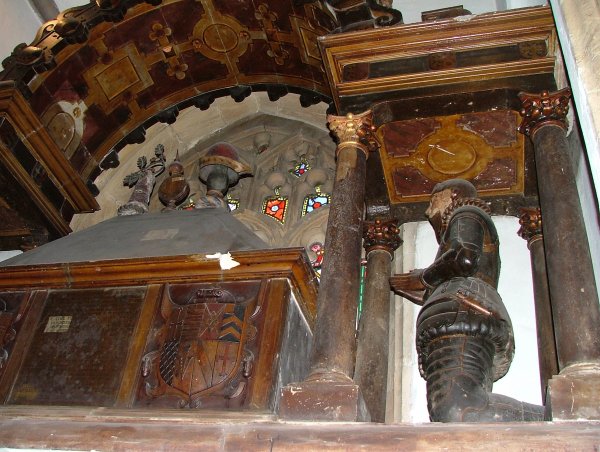
Monument to Sir John WILLIAMS in St Peters Church Dorchester
At the end of the north chapel, on a platform of masonry raised about 10ft from the floor, is an ornamental altar tomb and arched canopy, erected for Sir John WILLIAMS of Herringston, knight and his lady. it formerly stood on a raised tomb or mausoleum, which contained coffins, under the paneled arch which opens into the chancel, where it was a conspicuous and handsome object. Unfortunately however, it was found to interfere with the convenience of the congregation making use of this part of the aisle, as it obstructed both sight and sound, and, when, the church was restored and renewed in 1857, it was deemed expedient to remove it. It was then placed in its present awkward and incongruous position, where it is seen to great disadvantage, and its whole character is seriously impaired; whilst it blocks up the lower portion of the handsome east window, the effect of its heraldic decoration and other coloured ornaments is marred by the brighter hues of the stained glass immediately behind it. The monument consists of a central altar-tomb having square canopies on the same level at each end, respectively supported by four circular pillars with foliated capitals, and from the inner side of these canopies springs a massive circular arch with highly ornamented soffit and architrave, the whole surmounted by a sculptured and painted shield of arms, with the crest of Williams. As it stood under the arch, it was of course formerly visible on all sides, but one side which was ornamented similarly to the other with the exception of some of the coats of arms is now entirely hidden by the position it at present occupies. As remarked by Hutchins "it is adorned with painting, guilding and carved work", and is as rich a heraldic tinctures and devices combined with quaint sculptured ornamentation can make it. Under the respective canopies are the life size figures of Sir John and Lady WILLIAMS kneeling with the hands joined and upraised in the posture of prayer, and the eyes directed upon an open book which lies before each of the figures on the sloping ends of the altar-tomb. The knight is represented in full armour, bareheaded, with profuse moustache and pointed beard; the lady is in the well known costume of the period, and conspicuous in the habits of both, are the large stiff collars or ruffs then worn. The sides of the altar-tomb are divided into three compartments or panels, the central one containing the inscription hereafter given, and in each of the others is a sculptured and painted shield, one of which bears the arms of Williams, the other those of Uvedale, with their respective quarterings. The same arms are also impaled on the shield which surmounts the arch, viz Baron, Quarterly of six, 1. Argent, within a bordure engrailed gules, charged with crosses patée or and bezants, a greyhound courant in fess between three Cornish choughs proper, Williams. 2. Gules, three buck's heads couped argent attired or, De la Lynde. 3. Argent, a cross engrailed gules, Hartley. 4. Gules, three herrings hauriant in fess argent, Herring. 5. Sable, a cross floryargent, Syward. 6. Per fess argent and gules, a lion rampant within a bordure counterchanged, Cerne. Femme, Quarterly oif eight, 1 and 8, Argent , a cross moline gules, Uvedale. 2. Barry of twelve argent and gules, on a canton sable a crosslet or. 3 Gulkes, a fret vaire. Sable, two chevrons and a canton or. 5. Vert, fretty or. 6. Or, a pheonazure. 7. Argent, on a bend sable three eaglets displayed or. Crest, a hand couped above the wrist holding an oaken bough, both proper, fructified with acorns or, Williams. On the canopy over Sir John "NIL SOLIDUM, 1628," and above, the crest of Williams. On the lady's canopy, "TAVNT QUE JE PVIS, 1628," and over that, on a chapeau gules, turned up ermine, an ostrich feather argent; the cest of Uvedale.
The covering of the altar-tomb is about two feet in height, of a pyramidal form, with the apex cut off, on the top of which are carved and painted crests of Uvedale and Williams, standing on each side of an object which has a sun in glory painted on its circular disc, and the words "Fugit hora". At intervals, on the architrave of the arch, eleven shields are sculptured, with arms painted on them, and there are also painted shields on the frieze of the cornice over the canopies. These are arranged by Hutchins, in his description, as folloows, but some of the shields seem to have been transposed when the monument was removed to its present site.
On the front of the Cornice of Sir John's canopy, these coats from east to west (north side) -
I. Harang impaling Syward
II. Harang impaling Argent, three bars sable, on a canton gules three fusils conjoined in bend or.
III. Syward impaling Cerne
on the arch, from east to west
I. De la Lynde impaling Hartley
II. De la Lynde impaling Hartley
III. Williams impaling, Ermine, on a bend sable three martlets or, Cheney
IV. Williams impaling, Per pale, the first paly of six argent and sable, the second azure Trenchard
V. Williams impaling, De la Lynde
VI. Williams impaling,Uvedale
VII. Williams impaling, Gules, a chevron engrailed between three leopard's heads or, Peryam.
VIII. Williams impaling, Trenchard
IX. Azure, three columns or, Geffrey, impaling Williams.
X. Azure, on fess engrailed and cotised between three crescents argent three torteaux, - - impaling Williams.
XI. Argent, on a bend gules three leopard's heads or, within a bordure engrailed sable, Coker, impaling Williams
on the cornice of the Lady's canopy, from east to west -
I. Williams impaling, Gules, three covered cups within a bordure argent, Argenton.
II. Williams impaling, Argent, a chevron between three roses gules, Phelips, a crescent sable for difference
III. Williams impaling, Argent, three hurts each charged with two chevrolels gules, Carant.
On the south cornice of the lady's canopy these coats from west to east -
I. Uvedale, impaling, Vert, fretty or.
II. Uvedale,impaling, Gules, a fret varie.
III. Uvedale, with a crescent sable for difference, impaling Barry of six argent and gules, on a canton sable a crosslet or.
On the arch (south side) eleven coats from west to east
I. Uvedale impaling Paulet.
II. Uvedale impaling, Azure, semé of fleurs-de-lis or, a lion rampant argent
III. Uvedale impaling, Azure, on a bend engrailed argent three Cornish choughs proper
1V. Uvedale impaling, Gules, ten bezants, 3,3,3,and 1, a canton ermine, Zouch.
V. Uvedale impaling, Argent, on a bend sable three eagles displayed or, a crescent for difference, Erule.
VI. Williams impaling Uvedale, with a crescent sable for difference
VII. Williams impaling, Gules, a chevron engrailed between three leopard's heads or, Peryam.
VIII. Williams impaling Trenchard
IX. Geffrey impaling Williams.
X. Azure, on a fess cotised between three crescents argent as many torteaux, impaling Williams.
XI. Coker impaling Williams.
On the cornice of Sir John's canopy these coats from west to east -
I. Williams, with a crescent fpr difference, impaling Argenton.
II. Williams, with a mullet, impaling Phelips.
III. Williams, with a martlet, impaling Carant
The inscription is as follows
STIPENDIUM PECCATI MORS.
HERE UNDERNEATH REST THE BODIES OF SIR JOHN WILLIAMS, LATE OF HERRINGSTONE, KNIGHT AND THE LADY ELEANOR, HIS WIFE, DAUGHTER OF HENRY UVEDALL OF MOORE CRITCHEL, IN THE COUNTY OF DORSET, ESQUIRE, WHO HAVING LIVED TOGETHER MAN AND WIFE FOR FIFTY YEARS, IN WHICH TIME THEY HAD ISSUE SEVEN SONS AND FOUR DAUGHTERS, WERE IN THE YEAR OF OUR LORD 1617 DIVIDED BY DEATH FOR IN THAT YEAR THE 7th OF SEPTEMBER, DIED THIS KNIGHT, TO THE GENERAL GRIEFE OF ALL GOOD MEN AGED 72 YEARES. HIS LADY LEFT ALONE, LIVED ALONE, TILL SHE WAS AGAIN JOINED UNTO HER HUSBAND IN THIS PLACE, ON THE 14th OF APRIL IN THE YEAR OF OUR LORD GOD 1625 AGED 80 YEARS: WHICH THOUGH IT WERE A LONG LIFE, YET WAS IT SO GOOD AND VIRTOUS, THAT SHE LIVED AND DIED BELOVED OF ALL. SHE IN HER LIFE TIME, BY HER WILL, APPOINTED THIS MONUMENT, IN MEMORY OF HER DEAR HUSBAND, HERSELF, AND HIS ANCESTORS, WHO WERE BUILDERS OF THIS ISLE, TO BE ERECTED BY THE CARE OF GEORGE WILLIAMS, HER THYRD SON LIVING, AND SOLE EXECUTOR. WHICH WAS ACCORDINGLY PERFORMED AND FINISHED.
ANNO DOMINI 1628
REQUIESCUNT IN PACE, RESURGUNT IN GLORIA. UBI, MORS ACULEUS TUUS!
[Note:- The pedigree of the WILLIAMS Family is recorded on pages 97-99 in the Visitation of Dorset taken in 1623. Three pedigrees are registered by three different members of the family showing differing lines of descent. The first and third overlap.
and the third clearly shows that Sir John WILLIAMS referred to above was the son and heir of Robert William of Herringston by his 2nd wife Anne the daughter of Thomas DELALINE who was sister and heir to Sir George DELALINE Knight. John had 4 sisters, Mary the wife of Robert THORNHILL, Elizabeth, Anne and Edith. They had 3 children Robert the eldest, John and George Williams who married Mary daughter of William Carant of Tomar in Somerset.
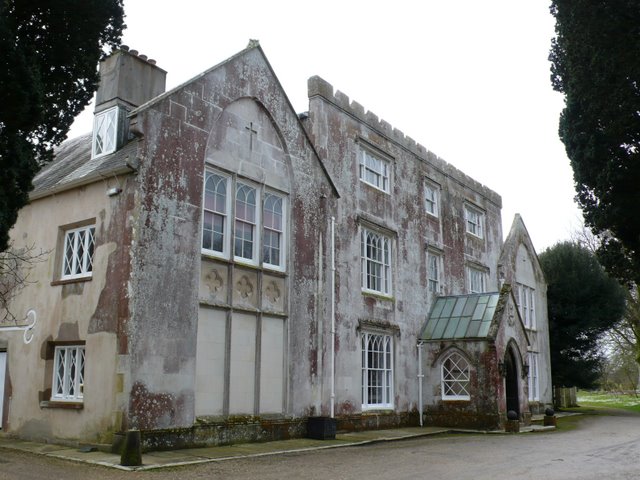
Herringston House Winterbourne Herringston
© Copyright Nigel Mykura and licensed for reuse under this Creative Commons Licence.
John WILLIAMS, of Herringston, esq his son and heir, by his will dated 29 May 1558, and proved 3 Feb. following, ordered his body to be buried in the aisle of St James the Apostle in the church of St Peter [Note:- I Have not been able to trace this will at the PCC ; Dorset Wills at DHC do not start until 1565]
Robert WILLIAMS, of Herringston esq son and heir of the last mentioned John, made his will dated 8 Oct 1566, which was proved 7 Oct 1569, and thereby ordered his body to be body to be buried in the same church. [Note:- Link to his burial" St Peters where some information given about his will]
A portrait of Sir John WILLIAMS, habited in a black vest with a large ruff similar to the one represented on the monument, still remains at Herringston, and a duplicate is in the possession of the Rev. John BOND of Tyneham.
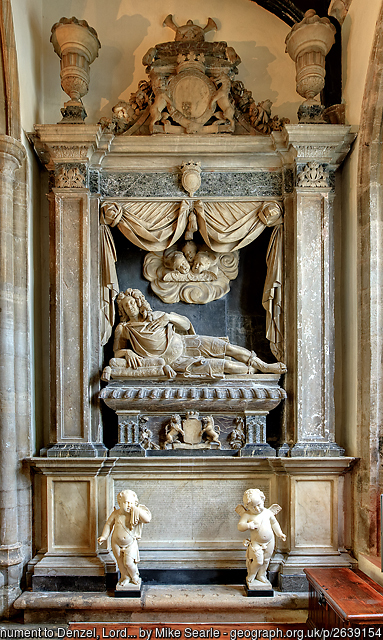
"On the south side of the chancel opposite the monument of Sir John WILLIAMS is a very lofty, noble, and superb one for the Lord HOLLES, of white marble, supported by pillars of varigated marble, railed with iron and filling up the arch between the chancel and south aile. On the top between two urns is an escutcheon containing the arms of HOLLES the Duke of Newcastle, encircled in a garter, quarterly of 12:
1. Erm. two piles in point S. Holles with a crescent of difference.
2. A. a lion rampant G. Estley.
3. A. on a chevron between three crosslets S. as many crescents of the first, Scopham.
4. Quarterly A and G on a bend S. three crosslets A. Hannan.
5. S, a crescent surpounted of a mullet A. Denzel.
6. A. a chevron S. between three black-moor's heads couped, Wenlock.
7. A three chevronels S, Archdekene.
8. A. s saltire S. between twelve cherries slipped G. Segeaulx.
9. Vere, with a crescent of difference.
10. G. a lion rampant A. vulned on the shoulder, Bolebeck.
11. Barry wavy of six A. and Az. A. a fess between two bars gemelles G. Badlesmere. In surout Cavendish, S. three buck's heads cabossed A. attired O. Supporters, a lion guardant tawny, ducally crowned, on the dexter side, and a tiger A. on the sinister. Over all a ducal coronet, and on a cushion above it a ducal cap . . . . Motto, SPES AUDACES JUVAT.
Below the crest, a boar passant Az. on his side a crescent A., on a cap lined with ermine, surrounded by the garter, the crest of Vere.
Below this, under a curtain, are three cherubim's heads, and below this the effigies of Lord HOLLES in a robe of loose drapery, in a cumbant posture, leaning his right elbow on a cushion. On each side of the effigies, on the outside of the monument, is on the right a boy, on the left an angel mourning. Under all are the arms, supporters, and motto of Holles, with a baron's coronet. In a compartment on the base are two columns; that on the right hand in Latin, on the left in Engish:
[I have not bothered with the left hand inscription which as stated above is in Latin - It can be located on page 383 of John Hutchins account - The English transcription is given below ]
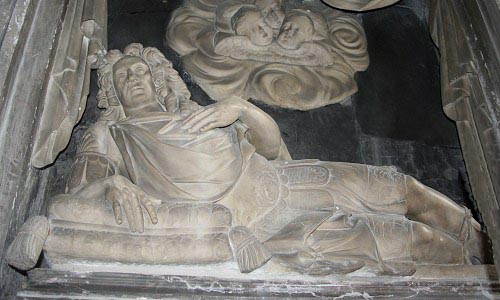
Monument to Denzil Lord HOLLES (1598-1680)
"To eternize the name and honour of DENZEL LORD HOLLES, Baron of Ifield"
"His birth was equal to his virtues, being the second son of John the first Earl of Clare, who, by sea and land, at home and abroad, did not more singalize himself in the service of his country than he was meritoriously distinguished and rewarded by Queen Elizabeth and King James. All that Denzil's wit or courage, probity or industry, presaged in his youth he made good and exceeded when a grown man, for, as his excellent endowments and abilities made him early known to his prince and country, so he could, by his eloquence and valour, intrepidly defend the liberty of the last without refusing the obedience that was due to the former. When the rights of the nation were barbarously invaded by that army which the Parliament levied to secure them, he bore the violence and injustice of his enemies as it became a finished hero. Nor could losses, exile, or his hatred to the factious make him forget the love that he owed to England. After the restoration of the Monarchy he was created Baron of Ifield by King Charles the Second, and had the honour or representing him in two extraordinary embassies, the one to Lewis the French King, who no less admired the generosity whereby he maintained so high a character than he dreaded that virtue he was not able to corrupt by his magnificent presents, which were more princely refused than offered. No part of his reputation was diminished when he went afterward as plenipotentiary to the treaty at Breda. His learning was unaffected, useful, and general; but not to be exceeded by any in the knowledge of the ancient records of the kingdom, and the distinct powers of the several parts of the administration. So true a friend, HE was as great a patron to religious as to civil liberty, which made him universally beloved and lamented, when he peaceably ended a long and glorious life the 17th February, in the year of Christ 1679(1), in the eighty-second year of his age. This monument is therefore dedicated to his memory for the honour of the present age as well as an example to posterity by his nephew's son and heir, John Duke of Newcastle. "MDCXCIX"
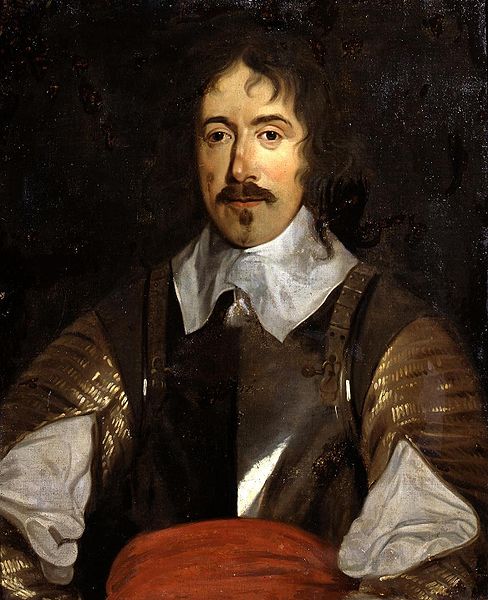
Denzil HOLLES 1st Baron Holles of Ifield
At the restoration of the church in 1857 his monument was removed to the west end of the north aisle.
Lord Orford describes Denzil Lord Holies as:-
-
"A character very unlike the Earl of Bristol's; the one embraced a party with levity and pursued it with passion; the other took his part on reflection, and yet could waive it, though his passions were concerned. The courage of Digby blazed by choice, that of Holles burned by necessity. Through their lives, the former acted from the impulse of great parts, the latter of common sense; and in both, the event was what in those cases it generally is. Digby was unfortunate and admired; Holles was successful and less renowned. On a strict disquisition into the character of the latter, he seems to have been a patriot both by principle and behaviour, and to have thoroughly understood the state of his country, and its relations with Europe; its dangers from royal power, from usurpation, from anarchy, from popery, from the increase of the French empire: on every crisis I have mentioned he acted an honest and careful part. He early opposed the enormous exertion of the prerogative by Charles I. and his ministers, carrying up the impeachment against Laud, suffering a severe imprisonment from his public spirit, and being marked by the King in that wild attempt of accusing the five members. Yet he seems to have been one of the first alarmed at the temper of those who proposed to chastise as well as correct, and who meant to retain the power as well as the office of punishment.
At the treaty at Oxford, where he was one of the commissioners from the Parliament, he ventured, in hopes of healing the distractions, to advise the King what to answer, an employment that clashed a little with his trust, and in which his sagacity did not shine; for, though the King followed his advice, it had no effect. However, the intention seemed upright, and his so easily forgetting the personal injuries he had received reflects great honour on his memory. He refused to act in the prosecution of Lord Strafford, who was his brother-in-law, and against the bishops, yet he was esteemed the head of the Presbyterian party; and, in the Isle of Wight, advised his Majesty to give up episcopacy.
The defects of his character seem to have been, that his principles were aristocratic,(a) demonstrated by experience to be the most tyrannical species of government, and never imbibed but by proud and self-interested men; that his opposition to the army was too much founded on a personal enmity to Cromwell; and that he sat on the trials of the regicides, who at worst but chastised the faults which his lordship pointed out. Lord Holles acted zealously for the Restoration, and, while the dawn of the King's reign was unclouded, accepted employments and embassies from the crown consistent with his honour and duty to his country. As soon as the Catholic rudder was uncovered, he again reverted to patriot opposition. When Sir William Temple's privy council was established, Lord Holles, though 82 years of age, yet never thinking himself past serving his country, accepted a place in it, but died soon after. His memoirs, which he wrote while in exile in France, are little more than the apology for his own conduct, and a virulent satire on his adversaries. The extraordinary wording of the dedication takes off all hopes of impartiality. It is addressed " To the un paralleled couple, Mr. Oliver St. John, his Majesty's solicitor-general, and Mr. Oliver Cromwell, the Parliament's lieutenant-general, two grand designers of the ruin of three kingdoms." Much temper was not to be expected from an exile in a religious and civil war. From the extreme good sense of his lordship's speeches and letters one should not have expected that weak attempt to blast Cromwell for a coward. How a judicatory
in a Temple of Fame would laugh at such witnesses as a Major-general Crawford and a Colonel Dalbiao ! Caesar and Cromwell are not amenable to a commission of Oyer and Terminer.(b) "
Hutchins page footnotes:-
(a) Yt has been objected to me that Lord Holles's writings seem to argue for democracy, but it is certain that the tenor of his conduct and of his "Memoirs" was to oppose and revile the low born and popular leaders as soon as they had deprived his lordship and his associates of their ascendance in the commonwealth. It is in vain for a man to pretend to democratic principles who prefers monarchy to the constitutional, natural, and necessary consequences of democracy. --Royal and Noble Authors, vol.ii.pp28-32.
(b) From Appe4ndix in last edition of this work.
Hutchins continues, " In a vault near this lies Sir Francis Ashley, knt. and his lady, eldest daughter and co-heir of Bernard Samwayes, esq. of Toller Fratrum.(c ) " In another his sole heiress and daughter, wife to Lord Holles, and one of their children. He was descended from the Ashleys of Wimborne St. Giles, and was of the Middle Temple, and reader there 1610. In 1615 he was made serjeant-at-law, and knighted 1618; was appointed steward of the Marshalsea of the king's household, 1 Car. 1625; king's serjeant, and recorder of this borough. He died at Serjeants' inn, Meet street, Nov. 28, 1635. "
Just below the step by which you descend from the chancel into the nave is this inscription on a plate of brass, in very old characters :
-
Hic jacent Will'us Sillon et Johanna ux ej [Here lie William SILLON and Johanna his wife - Hutchins also states in his notes " This brass is not found in 1865"]
-
GILBERTUS EDWARDUS ARCHER, M.D. - OB. MAIJ 22, 1747, MT. 47.
" Under an arch of antique work, in the wall, at the upper end of the north aisle, is an ancient altar-tomb, robbed of its brass plates, and no arms or inscription remaining, nor any tradition whose monument it is. Perhaps it may be for one of the family of Williams ; for the inscription on Sir John Williams's monument tells us that this aisle was built by one of his ancestors, three of whom were interred here. [Hutchins page footnote:- This altar-tomb is represented on the plate with the monuments. At the last restoration of the church, it was removed to the north side of the chapel. [Note:- Link to more information about him]
" Below this is a neat mural monument of white marble, adorned on the top with a large urn bearing the following inscription :
This urn is in memory of Joshua Churchill, Esq. of Gussage, in the county of Dorset, who died at Charminster, Jan. 14,1786, aged 34. [Note:- Link to more information about his family - includes a transcription of the latin memorial epitaph:-]
At bottom, on an escocheon, Sa. a lion rampant Ar. debruised by a bendlet G. Churchill, imp. Erin, on a canton Sa. a fleur de lys A. Awnsham.
On the monument is this epitaph:-
WILLIELMI CHURCHILL,
Viri probi, & integerrimi,
Patrise suse amantissimi,
Qui decessit 17 Julii, a.d. 1706,
Natus Annos 78.
Uxorem duxit ELIZABETHAM,
Filiam Nicholai Awnsham de Isleworth,
in comitatu Middlesexiae,
Feminam pietate & virtute insignem.
Quffi obiit 20 Junii, 1714,
Annos nata 84, & juxta jacet.
Liberos decem susceperunt, quorum nomina sunt
Elizabetha, Awnsham de Henbury, Maria,
Willielmus de Dalingho, in com. Suffolciae,
Johannes de London, Joshua de Gussage,
Jana, Sarah, Susanna, & Richardus
Qui infans decessit.
"On the floor, on a coarse grey marble, is the effigies of a woman in an antique dress, kneeling. Over her head, on a label
-
Miserere mei D's s'dum magnam miam tuan.
-
Dic jacet Johanna de Sto Oero, relicta Rob'ti MORE, que obitt in bigilia Ste Trinitatis s'c'do Die mensis .... Anno D'ni MCCCCXXXVI. [i.e.1436] cui A'ie p'piciet' D'Amen
[Note:- See also the entry 76 in the 'Memorial Inscriptions in St Peters Church File' - also John Hutchins page footnote " The Scroll in 1865 remains, but the brass is now lost. VOLII"
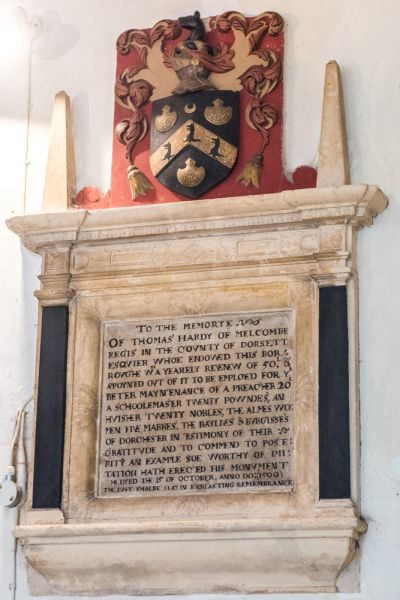
Thomas Hardy Memorial 1599
© Copyright Licenced by Britain Express Image Library
"On a tablet of white Marble against the south wall this inscription in Roman capitals, and over it Sa. on a chevron between three escallops or as many dragon's heads erased of the first; a crescent for difference:
THOMAS HARDY OF MELCOMBE REGIS, IN THE
COUNTY OF DORSETT, ESQUIER, WHOE ENDOWED,
.THIS BORROUGHE WTH A YEARELY REVENEW OF
50L; AND APPOYNTED OUT OF IT, TO BE EM-
PLOYED FOR YE BETTER MAYNTENANCE OF A
PREACHER, 20L; A SCHOOLMASTER, TWENTY
POUNDES: AN HUISHER, TWENTY NOBLES; THE
ALMES WOMEN FIVE MARKS. THE BAYLIVES
AND BURGESSES OF DORCHESTER, IN TESTIMONY
OF THEIR GRATITUDE, AND TO COMMEND TO
POSTERITY AN EXAMPLE SO WORTHY OF IMITA -
TION, HATH ERECTED THIS MONUMENT.
HE DYED THE 15 OF OCTOBER, ANNO DO: 1599.
Crest, a talbot's head erased. [Note:- Link to entry under Burials below]
"Near it, on the floor , on a brass plate, on a coarse grey marble, this inscription in old English characters: " Hic jacet Editha HAYWARD, nuper uxor Rici HAYWARD, Mil: obit XIII die Junii, Ao: Dni: M......XII, cuj: a'le p'piciet D' Amen" [Note:- See also the entry 77 in the 'Memorial Inscriptions in St Peters Church File']
"Below this, on a brass plate, at the entrance into a seat: "Here lyeth the body of Mr Oliver HAYNE, one / of ye capital burgesses of this towne, who / departed this life ye 12th of Decr: 1822, aetat: suae 59", [Note:- Link to an account of the HAYNE Family of Dorchester]
"Several grave-stones, whose brasses have been torn off, are scattered up and down in this church.
""On a square piece of black marble, placed on the west side of the tower, just on the right-hand going up the stairs in the churchyard to the gallery, is the following inscription:
Thomas PLANE
born at Tanfield in Yorkshire
buried hard by these stairs
December the 16th 1725, in the 43d year of his age
Conyers PLACE, clerk
with whom he lived 28 years
faithful, sober, quiet and religious
dedicates this testimony
of his grief, gratitude, love and losse
of his servant, countryman, friend and brother"
Note:- Link to image of Memorial plaque for Thomas PLANE (1682-1725) and transcription of his will]
"In the south side of the churchyard, on a brass plate on a tomb, under the wall of the south aisle, a little east of the porch:
-
JOHANNES, filius 12mus THOMAS GOLLOP, Strode Netherburiensis, armigeri; vir admodum Christianus, Dorcestriæ diu incola, magistratus laude dignissimus; obit 25 Aug 1731, anno ætatis
suæ 71. Dissoluto connubio priore, proximâ tabulâ memorato, FRANCISCAM, Henrici Backway, gen. viduam, uxorem duxit, feminam inculpatam, & pietate insignem, quæ
obiit 14 Mar 1712. Non omnis mortua est.
"On another brass plate on the same tomb, now removed, was the following inscription: [Note:- Link to Burial Register and image of plaque]
D.I.O.M.
Maria GOLLOP
Uxor D. Johannis GOLLOP, filia D Phillippi STANSBY,
Hujus Dorcestriæ mercatorum,
Annos 29 nata, octonos nupta,
STRODE in Netherbury, amœnæ sedis Gollopensis,
Raptim mortua Maii 25, 1682,
Eodemque mensis die sepulta quo maritata,
Tribus filius una hic sepultis,
Totidemque apud vivos feliciter relictis,
Mortalitatis exuvias lætè deponrns,
Lætioremque resurrectionem pientissime expectans.æ
Flebilis hic recubat fati sub tegmine, nunquam
Fecerat heu ! mæstos intumulata suos;
Urbanæ pietatis erat, mentisque capacis,
Innocuisque placens moribus, uxor amans,
Sacra dies thalamo fuerat quæ sacra sepulcro,
Digna viro vixit, mortua digna Deo.
"On a brass plate, fixed in the wall of a house on the south side of the churchyard:
Die omnium sanctorum sanctus hic è luce migravit, & in cœtu sanctorum recessit, anno salutis 1649. Cujus fidelis conjux Maria per novem annos duos menses & octo dies ipsum supervixit, & hic requiescit a laboribus, & opera ejus illam sequuntur. [Note:- Link to more information about William DERBY (1588c-1649) One of the 119 investors in the Dorchester Company]
"Parallel to, and south of, Mr Gollop's an altar-tomb, having on two compartments these inscriptions":-
-
(1). Here lieth the body of W. ADYN, sone of John ADYN, who departed in faith . . . xxviii [i.e. 23rd] day of . . . . . anno . . . .1577
(2). Off your charitie . . . . . . w . . . . . . of John ADYN, who departed in the faith . . . . . . . . . . [Note:- Link to St Peters Monumental Inscriptions file.]
" A little to the south of the former another altar-tomb:-"
Hic futuræ resurrectionis spe, cum duobus liberis filio nataq; jacet Daniel ARDEN Fab. Aur. Ar. (i.e. Faber Auri Argenti) qui oblit VIII Novemb. MDCLXXI, annoq; ætatis XLVIII
-
[Note:- Link to St Peters Monumental Inscriptions file.]
" A little west of the former, near the inscription for Mr DERBY, an altar-tomb, on two compartments, inscriptions for William SPEERING, who died 164? .. and Avis his wife, who died 1665."
-
[Note:- Link to St Peters Monumental Inscriptions file. which has more detail of the original inscription]
Besides the monuments thus noticed in the former edition of this work there are others, as follow:-
(1). In memory of the Rev. John Morton COLSON, LL.B., 41 years Rector of Dorchester St peter, who died on the 14th of September 1863, and was buried in a vault in the churchyard
-
[Note:- Link to a summary of the life of Rev. John Morton COLSON LLB (1791-1863) an image of the plaque and more Information about his ancestry]
-
[Note:- Link to more Information about her ancestry]
(4) Sacred to the memory of George CLARK, upwards of sixty years an inhabitant of this town, who died April the 16th, 1846, in the 80th year of his age; also Frances , his beloved wife who departed this life January 3rd, 1814, aged 42, and of Thomas, their son, who died April 21st, 1846, in his 47th year; also of their son "Charles CLARK, Captain in the Bengal 1st European Regiment, who died October 13th, 1846, aged 37, after protracted suffering from severe wound received at the battle of Ferozeshah. His mortal remains are deposited at Soobathoo, where officers of his Regiment, in testimony of their friendship and regret, have erected a tomb to his memory. [Note:- Link to an image of the monument and more information.
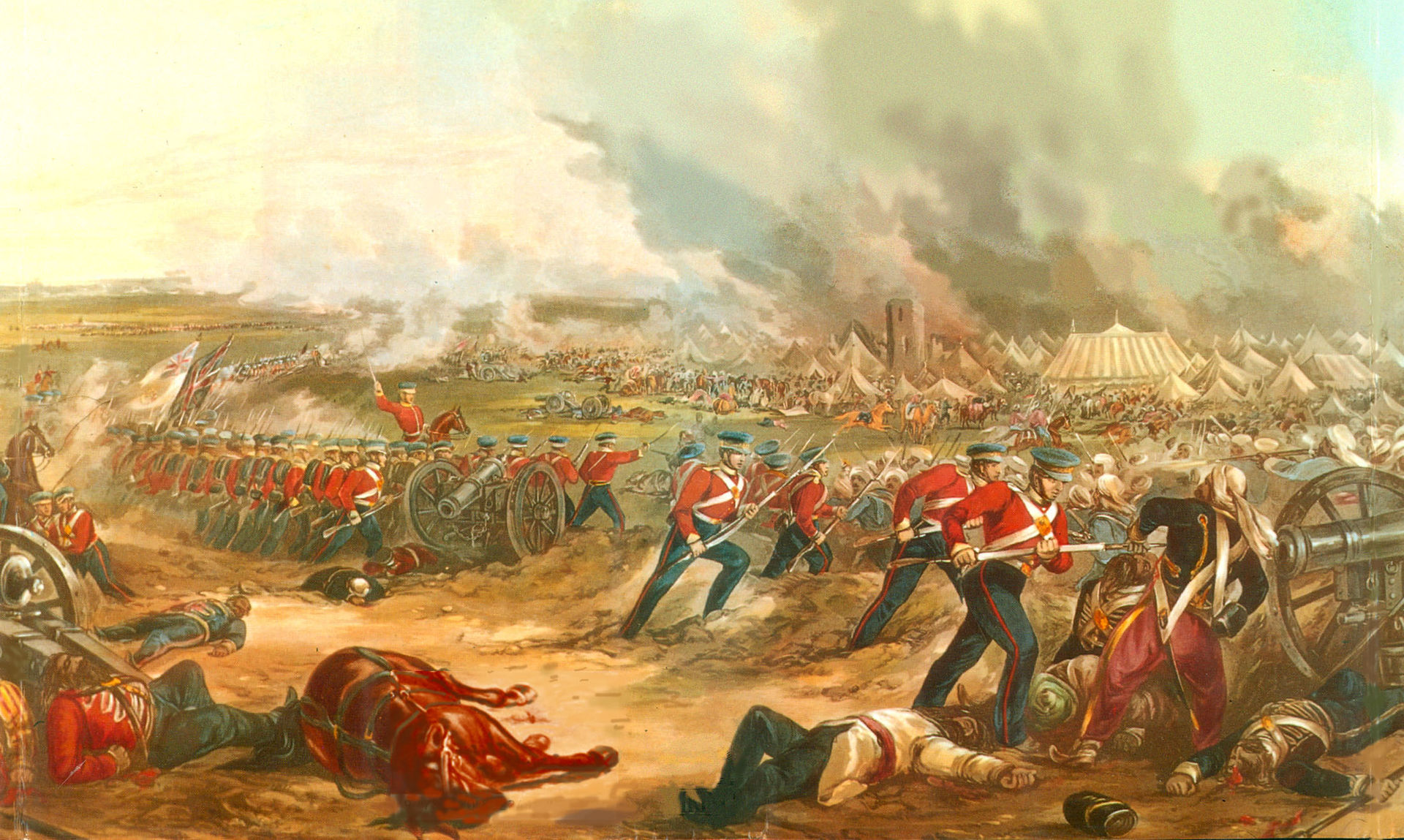
Picture of The Battle of Ferozeshah on 22 Dec 1845 by H Martens
(5)To the memory of John BASCOMBE LOCK (a native of this town), Captain in the 5th Bengal Native Infantry, who died in the Khybur Pass, Upper India, January 24th , 1842, aged 34 years. He fell in action with the Affreedies whilst bravely struggling to convey the succour so much needed by the British forces in Afghanistan. [Note:- Link to an image of the memorial in St Peters Church and more information and links about his family. Also Link to an account of the 1842 Retreat from Kabul involving 16,000 people of whom there was only 1 survivor]
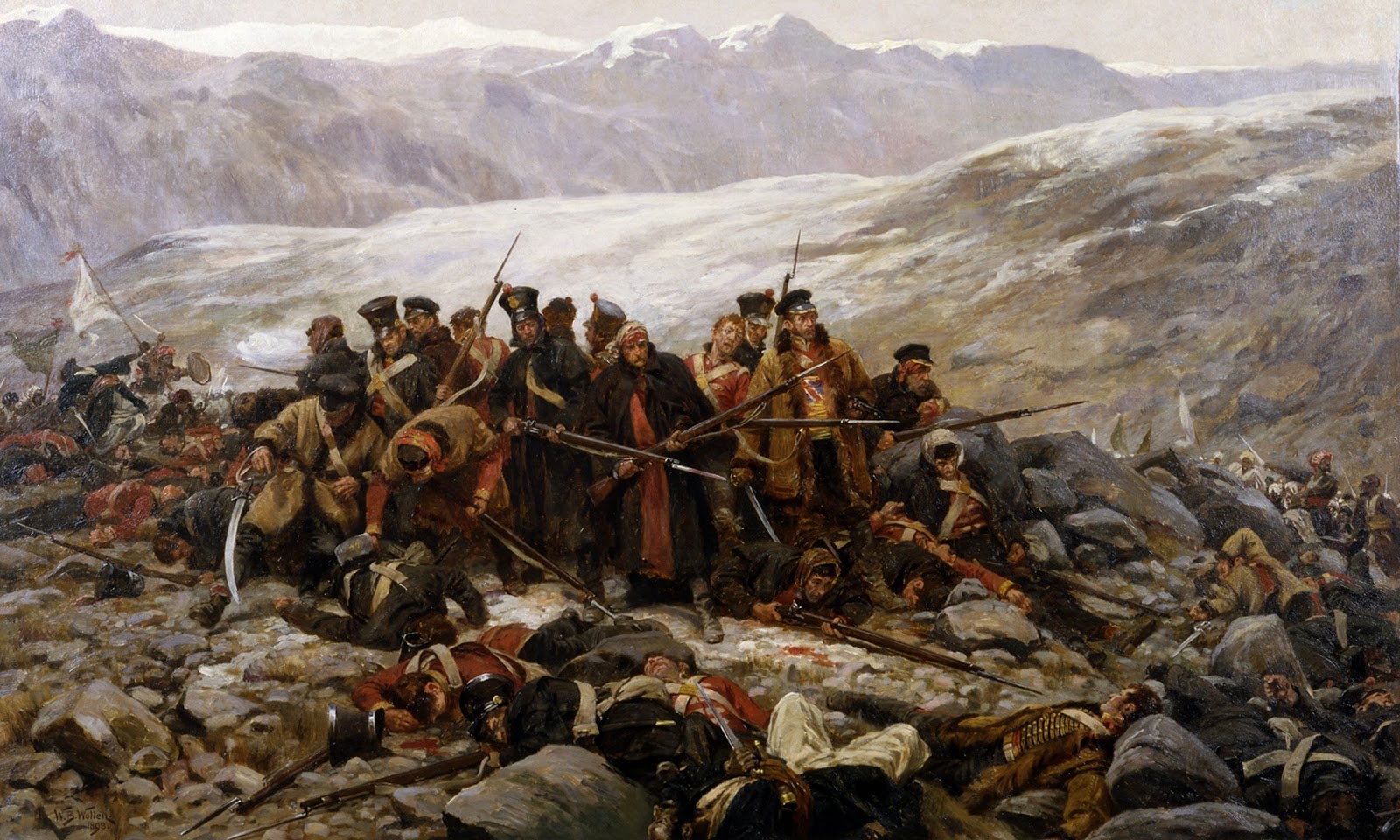
1898 depiction of The Last Stand of 44th Regiment, part of
The 1842 Retreat from Kabul
(6) To the memory of John WILLIS, esquire (a deputy lieutenant of the County of Dorset), who died December 15th 1834. [Note:- Link to image and more information]
(7) "Sacred to the memory of Henry TOOZE, esquire who held the commission of barrack master at Dorchester for thirty four years and died 15th May 1828 aged 61 years . Also of Susanna his wife, who died 24th March 1846 aged 84 years. [Note:- Link to and more information]
(8) Sacred to the memory of Mary BLANDY, many years an inhabitant of this parish, who died 4th March, 1844 aged 47 years. [Note:- Link to and more information]
(9)This monument is erected to the memory of George, son of William CHURCHILL, esq., of Colleton, Captain in the 34th Regiment of Infantry, in which he served many years in North America. He died on the 6th day of June, 1814, in the 69th year of his age. [Note:- Link to and more information]
(10) Alfred, second son of John GREGORY, died October 24th, 1848, in the 18th year of his age [Note:- Link to image of memorial and more information]
(11) Sacred to the memory of Mrs Mary SHERGOLD, who died on the 2nd of June, 1840, at her house in the parish, in the 91st year of her age , respected and beloved by all her acquaintance, but more particularly endeared to three generations of the CHURCHILL Family, to whom she was distantly related, by her uniform kindness and attention to them in youth, age, and sickness.
(12) This monument is erected by the three surviving children of William CHURCHILL, esq: of Colliton to the memory of their beloved father who died the 1st day of December 1799, in the 61st year of his age and was buried at Puddle Hinton with his sister Elizabeth, the wife of the Revd: Nathaniel: TEMPLEMAN & their ancestors ; Also to their beloved mother, Jane CHURCHILL, who died on the 12th of April 1801, in the 54th year of her age and was buried in this church with her daughter Sophia, who died on the 2nd December 1800, in the 21st year of her age . This addition to the above monument was made in testimony of fraternal affection to the memory of Caroline Frances CHURCHILL one of the above mentioned children of William Churchill, Esq: of Colliton who died May 10th 1808, the 19th year of her age. [Note:- Link to more information]
(13) Near this spot lie the remains of Mrs Elizabeth COZENS who died on 9th March 1821, aged 84 years. She was the youngest daughter of the late Revd: Edward COZENS A.M. Rector of Yarlington, in Somersetshire , and Master of the free Grammar School in this Town. By her last will dated the 19th of November 1818, she bequeathed to the Rector and Ministers for the time being of the parishes of Holy Trinity, St Peter and All Saints in Dorchester and to Benjamin JEFFRIES and James PARSONS, £500 stock in the Navy Five per cent annuities in trust to apply the interest in January yearly as follows vizt: among the poor women , aged 50 or above, of good character and not having received parochial relief within six months preceding, resident in St Peter's £6 Holy Trinity £5 and in All Saints £5 and equally amongst the inhabitants of Chubb's Almshouse £3 of Napper's Almshouse £2. 10s And of Whetstone's Almshouses £2. 10s . To record to posterity the above bequests pursuant to her will and in grateful remembrance of her many virtues, her relations and executors Benjamin Jeffries and James Parsons have erected this monument . [Note:- Link to more information and image of Monumental Tablet]
(14) In memory of Henry PLOWMAN, Surgeon R.N. who died at Dorchester, in the County of Dorset March 1st 1842, aged 62 years Also of / Frances Louisa, his wife who died at Kempston in Bedfordshire February 27th 1857, aged 56 years [Note:- Link to more information and image of Monumental Tablet]
Under the WILLIAMS' monument affixed to the wall of the dais before mentioned, in the north chancel aisle, are the following brass plates inscribed:-
1. In memoriam. James Wilmot WILLIAMS, 4th May 1845 ætat. 46 [Note:- Link to image of memorial and more information about James Wilmot WILLIAMS (1798-1845) ]
2. "To the memory of Edward Wilmot WILLIAMS Esq; of Herringstone, Dorset died 3rd January 1854 aged 88. [Note:- Link to memorial and more information]
3. "In a vault underneath are the remains of Sydenham WILLIAMS of Herringstone , esqr: He was twice High Sheriff of this county. Govr; of Portland Castle, and an upright magistrate. He married Agnes, the daughter of Nicholas FORWARD, M.D. of Exeter by whom he left two sons and four daughters. He died the 13th of May 1757, aged 56. Also of Thomas WILLIAMS of Herringstone, esqr; the eldest son . He married Jane, daughter of Sir Edwd: WILMOT, bart by whom he left issue. He died April 11th 1775, in his 48th year. Also of Agnes widow of the said Sydenham Williams who died Augt: 18th 1783, aged 83. Also of their daughter, Margaret WILLIAMS who died Octr: 8th 1826, in her 94th year. This tablet is dedicated to their memories by the Revd J.WILLIAMS Vicar of Merston, in the county of Somt: and Prebendary of Wells A.D.1830". [Note:- Link to an account of the life and ancestry of Sydenham WILLIAMS (1701-1757) ]
The two following monumental inscriptions, the originals being still in the church, were printed in the last edition of this work.
On a tablet of white marble, adorned on the top with a large urn bearing this motto, 'Omnes una manet nox'.
"Near this place lies the body of John GORDON, esqr; son of Robert GORDON, esqr: of Pronsey, grandson of Sir John GORDON, baronet, of Embo, in Sunderland. He died at Dorchester, Oct 4th 1774, aged 46 on his return to (from?) Jamaica where he had resided many years in universal esteem He was signally instrumental in quelling a dangerous rebellion in that island in the year 1760 a large body of negroes whom his bravery had repulsed, finally yielding to their confidence in his humanity. This monument is erected as a mark of affection to the memory of the best of brothers". [Note:- Link to an Account of the life and ancestry of Dr.John GORDON (1728-1774) a native of Scotland who lived in Jamaica and died at Dorchester]
Arms. Azure, a chevron between three boar's heads couped or.
Crest. A boars head couped.
The other inscription is as follows :-
Juxta sacrum fontem requiescit HENRICUS DUNSCOMBE sextæ legionis equitum (scilicet Inniskilling) signifier. Qui animam Deo reddidit et corpus sepulchro 15° Sep. 1788 ætatis suæ 20° [Note:- Link to image of memorial and more information about Henry DUNSCOMBE (1768-1788) ]
Arms. Per chevron engrailed argent and gules, three talbot's heads erased; impaling Gules, a bend between six fleurs de lys argent.
On the West side of the porch is a mural monument bearing inscription:-
Infra sepulta est præmatura direpta variolis MARIA filia ter optime dilecta Joh: et Alisæ HUGHES. Obit Dec. 13 A.D. 1739, Ætatis suæ octavo.
[Note:- Link to image of memorial and more information about Maria HUGHES (1731-1739) whodied from smallpox at the age of 8]
In the churchyard is an inscription on an altar-tomb adjoining that of Daniel ARDEN before mentioned. On its two compartments are the following inscriptions:-
1.
WILL • HAVE • A • HAPY • DEATH •
A • D • 1640 •
HERE • RESTYTH • THE • BODY • OF •
WILLIAM • SPEARING • DECEASED •
THE • 25 • OF • AVGVST •
AND • HIS • WIVES • SARA •
AND • MARY • AND • HIS • CHILDREN •
2.
AVIS • THE • RELICT • OF•
WILLIAM • SPEERING • WHO •
DYED • JVNE • 31 • 1665•
[Note:- These memorials have since vanished from St peters churchyard. Link to more information in St Peter's monumental Inscriptions file]
THE REGISTERS begin 1653.
[Note:- I have decided not to transcribe the long list of baptisms, marriages and burials provided by John HUTCHINS, first because they are abbreviated entries generally only giving the year, secondly because they are not particularly accurate, and thirdly because they represent only a brief random selection of a few of the more prestigious inhabitants. Conversely all the surviving parish registers have been fully transcribed and are available to view on this site. What I have done is added the initials [HACD] at the end of an entry to indicate that an abbreviated entry for it was listed in " The History and Antiquities of the County of Dorset".
John HUTCHINS confirms that the burials registers start in 1653 but then includes:-
BURIALS:
Anno Domini 1599, Thomas HARDY, armiger, fundator schoæ grammatieæ Dorcestrie, olit in ædibus Johannis BROWNE de Frampton arm. decimo quinto die Octobris 1599, & sepultus est 18° die ejusdem mensis, in parvulo sacello in australi pate eccesiæ Divi Petri villæDorcestriæ, anno supradicto. [Note:- Link to image of Monument]
1645, Mr.Stephen THORINGTON buried Oct 13 , at which time plague of pestilence was here; and in twelve months there died fifty-two persons whose names are not inserted, the old clerk, being dead who had the notes.
1648, July 24 , Mr John WHITE, minister of God's word, was buried, after abiding forty-one years minister of this town.
1649, Junii 26, The Lady ASHLEY
Clarissimaamplissimaque fœmina Dom. Anna ASHLEIA, clarissimi domini Francisci ASHLEY, equitis aurati, vidua, atquefilia bata maxima & cohæres Bernardi SAMWAYES, arm. (ultimi hæredis familiæ de SAMWAYES de Toller Fratrum in com. Dorset), obiit in sua domo de Friierie in parochia D. Petri Dorcestriæ , vespere diei Dominici x die mensis Junii, anno Christi MDCXLIX. & sepulta fuit in sacello ecclesiœ dieti D. Petri Dorcestria, die Martis XXVI ejusdem mensis anno supradicto.
FRATERNITIES:
There were three fraternities in this church, dedicated to Saint Mary, The Holy Cross, and Corpus Christi
Fraternity of the Blessed Mary: (2)
21 Ric II: [1397] (3) John GRAY (4) and Joan his wife granted to Thomas WOLPENNE, peyntour. of Dorchester, and Matilda his wife, a burgage on the east side of South Street, between the tenement of the Fraternity of the Blessed Mary, in the church of St Peter, on the north, and that of William PAIL on the south. (5)
John JOOSE, of Dorchester, by will dated March 20, 1420. left to Joan his wife, for her life, his tenement on the south side of East street in Dorchester, between the tenement of the Master of the Hospital of Mayne, on the west, and the cemetery of the parish church of All Saints , on the east, rendering annually to the Fraternity of St Mary , in the church of St Peter at Dorchester, 5s., by equal portions, at the four principal terms, reversion after her decease to Philip SPRAKE, clerk, and William BAKER of Dorchester to sell and dispose of the same for the health of his soul, &c.
By charter, dated 28th March, 3 Edw IV.(6) Robert MOREY's, chaplain, and John PASCO, steward or warden of the Fraternity of the Blessed Mary, in the church of St Peter of Dorchester, gave and granted and for themselves and their successors, in the fraternity aforesaid, confirmed to William SYMONDS, alias WATTYS, and Agnes his wife , a burgage with curtilage, standing on the east side in the South street of Dorchester, between the tenement of the Abbot of Abbotsbury on the north, and the burgage of Alice DRAYTON, on the south, and they warranted the same to the said William and Agnes against John ABBOT of Abbotsbury and his successors. In witness whereof the seal of the office of the seneschal or warden of the said fraternity was appended, and because that seal was unknown to many the seal of the bailiffs of the borough of Dorchester was also appended: Witnesses, John SAUNDER and Richard DOYLY, the Bailiffs, Robert GRENE, Walter GRENE, John DIER, Thomas WILTON, Roger ARTUR, Richard AYLEMER, John BARON, and others.
Dated 4th Mar 1420 - Proved 4th Aug 1421
See Also Charter 364 MRD
In the name of God Amen, the fourth day of the month of March 1420, and the eighth year of the reign of King Henry the Fifth, I Robert GRENELEFE alias BAKER, of Dorchester, do make my will in this manner. Impremis , I bequeath my soul to God and my body to be buried in the church or churchyard of the church of Holy Trinity, according to the order of my executors. Item I bequeath to the fabric of the cathedral church of Sarum 12d.; to the fabric of the church of Holy Trinity aforesaid 40 pence; to the fabric of the church of All Saints , Dorchester 40 pence; to the fabric of the new construction of the body of the church of St Peter, in the same town, 20 marks. Also I bequeath to my rector for tithes forgotten, 6s 8d; to the Friars Minors of Dorchester my best basin with ewer and my best brass pot. Also I bequeath to John MORTON, clerk John JURDAN of Wolveton and Robert MOSE, all my lands, burgages, tenements, rents, and services, with their appurtenances, in Dorchester and Melcombe Regis, in the County of Dorset to have and to hold, &c. to the said John MORTON &c. and their assigns in perpetuity of the Lord the King,. in capite, &c. Also I bequeath to John MORTON, John JURDAN and Robert MOSE, three silver bowls with covers, of my best bowls, namely,to each of them one bowl with its cover, the value of the same to be distributed to the poor for my soul and the souls of my wives. And in like manner to sell and dispose of all the aforesaid lands,tenements &c. as to them it may seem best, and the money thence arising to be distributed to the poor and needy, as well for my own soul as for the souls of my father and mother, of Eleanor my late wife, of my other wives, and all our benefactors. Also I ordain, make and constitute the aforesaid John MORTON and John JURDAN and Agnes my wife my executors to fullfill and accomplish my aforesaid will. Also I give and bequeath to John MORTON 7 marks, to John JURDAN 7 marks, and to Robert MOSE 7 marks; and I will that my executors shall distribute as well on the day of my burial as on the day of my obit to every poor person coming 1 penny. Also I give to the Fraternity of the Body (de corpore, Corpus Christi) in the church of St Peters in Dorchester , 3 marks, also to the Fraternity of the Holy Trinity 2s; and the rest of my goods not bequeathed after discharge of my debts I give and bequeath to my executors to be disposed of for my soul as aforesaid.
Richard BRYCE by will dated on Sunday next before the Feast of the Blessed Mary the Virgin, 1442 bequeathed his soul to God and his body for sepulture in the church of St Peter at Dorchester. Itm I leave to the fabric of the church of the Blessed Mary of Sarum 3s 4d. Itm I leave to ther Fraternity of Corpus Christi in the church of St Peter aforesaid 1 sheep. Itm I leave to Alianor my daughter my best cloak. Itm I give and leave to Thomas BRYCE my son my burgage with its appurtenances on the west side of South Street in Dorchester between the burgage of Robert CHILDECOMBE on the north and the burgage of the Blessed Mary on the south. Itm I leave to Alianor my daughter aforesaid one perch of land called Payne on the west side of South street against the field of the "West Wallys" between the garden of Robert CHILDECOMBE on the north and the garden of Abbot of Middleton on the south. [Note:- See Charter 489]
By deed dated Dec 1, 18 Hen VIII. John WYLLYAMS [WILLIAMS] and Roger HOWELL, keepers or wardens (custodes sive gardiani) of the Fraternity of The Blessed Mary, in the church of St Peter's within the borough of Dorchester, with the unanimous assent and consent of all the brethren and sisters (confratum et consororum) of the said Fraternity, granted to John STRATFORDE goldsmith of Dorchester, their two burgages on the west side of the High South street, in the parish of St Peter, one of which laid between the burgage of the said John STRATFORDE on the north and the burgage of the Prior or Chaplain of St John the Baptist in Dorchester on the south, and the other laid between the said burgage of the aforesaid Prior or Chaplain on the north and the burgage of the Bailiffs of Dorchester on the south &c. Witnesses Lawrence BALNER, Edward WELYS, bailiffs of the said borough; Reginald RAWLEYN,Robert JAMYS constables of the same; William STONE senior, Nucholas PERHAM, John ADEN, William PALMER, John JAMYS, Robert WYLLYAMS, Richard HOWELL, John HARDWARDE John SAMWAYS, Richard PERHAM, and others (Cop Archives).
In the chantry roll the Fraternity of Our Lady here was valued at £93s or £10 13s 8d. Here was one chalice ; the revenue employed to repair the church.
The return to the commission, 1650, for St Peter's, was, they had no parsonage or vicarage till after the expiration of a lease for two years yet to come, and then there is payable £80 per annum to the minister out of the impropriate parsonage of Fordington. Mr Stanley GOWER is minister. No chapel, nor is the church to be united. No nee4d for a new church or chapel, or of a division of the parish.
Although independent of any other church or chapel, fromthe smallness of its revenues, it seems to have been frequently held in connection with the rectory of Holy Trinity.
-
June 26, 1657
Whereas by the charter or ordinance of Parliament for the impropriate parsonage of Fordington there is provision made of eightie pounds a yeare for the minister of Peters in Dorchester, Wee the Mayor, Bailiffs, Aldermen and capital Burgesses of Dorchester aforesayed, by whose sole procurement the said charter or ordinance was obtayned, do hereby declare that our intention thereby wasnot to make Peter's a distinct parish from TRinity, but for the enabling of the Rector of Trinityto keepe and mayntayne an assistant for the better supply of the two churches of Trinity and Perter's, which time out of mind beyond the memory of man have always bin held and supplyed by the Rector of Trinity and his curate or assistants; and whereas by reason of some expressionsin the sayed charter or ordinance some question hath arisen about the manner of bringing in the sayd assistant to cleare up our meaning and intentions therein we have thought fitt to declare, and wee do hereby declare Mr. Stanley GOWER minister of Trinity and Peter's, as Mr WHITE and his predecessors have formerly bin, and that the sayd eightee pounds per annum is vested in him for the benefit of an assistant, hereby desiring Mr GOWER to assign the payment thereof to such assistant minister as the sayd mayor signifie his consent under his hand that the arrears of the sayd eighteie pounds per annum during the vacancy of an assistant already due together with whatsoever profits shall arise by reason of any future vacancy shall be proportioned and disposed of by the sayd mayor and corporation as they in their judgements shall judge most agreeable to the ends for which it was obtayned. In Witness whereof wee have hereunto sett our hands, Thomas SYMONDS Maior, &c
I do willingly consent to this order,
Stanley GOWER, Minister of Trinity and Peter's in Dorchester
The church of Saint Peter, in thr free borough of Dorchester, is in the gift of the King, of which one moiety is vacant, value 30s., and the other moiety is held by Master Alexander de Dorset of the gift of King John, value 30s.
Hutchins says, "Through it is the largest, best, and principal church of the town, it is only a chapel to the Holy Trinity, and has been so since 1303, and perhapsbefore; yet there are two instances in the Sarum registers of institution wherein the King presented, as a distinct rectory, viz Galfrid de Hardwick, presented by the King to this rectory, inst. Nov.1350, on the resignation of Simon Macy. John ROLAND was presented by the King to this rectory on the death of John ROPKYN inst. 27 April 1379. But it is to be observed that Macy, Roland, and ROPKYN were also rectors of the Holy Trinity. In the Valor 1291 it is joined with the Holy Trinity; but it is not mentioned in the modern Valor."
In Jan 1752, on the death of Dr.Leigh, the Rev John HUBBOCK received a sequestration authorising him to take the profits of St. Peter's.
In 1781 the Rev N.TEMPLEMAN succeeded to it in the same manner, and in 1813 the Rev H.J.RICHMAN also obtained a sequestration. In August 1821 the Rev.John Morton COLSON, LLB was presented by the Lord Chancellor in right of the Crown, and in Oct 1822 instituted and inducted. In 1830 Mr COLSON vacated, and was agaion presented by the Lord Chancellor. The income os St Peter's upon Mr. COLSON's first institution consisted only of £15 per annum, arising from surplus fees and Easter offerings, with a moiety of some tithes of gardens in the parish ; but, upon a representation made to the Governor of Queen Anne's Bounty, they endowed the Rectory with £2000, and further private benefactions were then bestowed £200 by the Earl of Shatesbury, £500 by Francis John BROWNE, and £500 by Robert WILLIAMS Esq M.P. Upon this the Governors of Queen Anne's Bounty were pleased to contribute a further sum of £1500 out of Parliamentary-grant funds. All these sums with the exception of £750, disbursed in the purchase of a parsonage house in the adjoining parish of Fordington, are invested in the Three per Cent Annuities. Mr Colson died Sep 14th 1863 and in the following yearthe Rev Edmund Ward PEARS MA of Magdalen College Oxford and formerly curate of Stoke Goldington Beds was instituted on the presentation of the Lord Chanc, and is the present incumbant.ellor
CHURCH ESTATE: Parish of St Peters (Extract from pages 401-405)
There is a messuage and garden in the parish of Holy Trinity situate on the north side of Pease Lane which has always been considered as belonging to the church of St Peter, the profits of which are carried to the account of the church rates.
Genealogical Notes:-
(1). Although the memorial states Lord Holles date of death to be 17th February 1679 [i.e. the year started on 25th March so this more correctly recorded as 1679/80] his burial took place at St Peters church in Dorchester on 10th April 1680. If he was 82 he was born in 1598. 1680 has been accepted as the year of his death in the Dictionary of National Biography
(2). There is an earlier Charter in the Municipal Records of Dorchester (not listed by Hutchins) which refers to the Fraternity of the Blessed Mary which is Charter No. 22 dated in 1396. [Follow link]
(3). The 21st year of the reign of Richard II ran from 22nd June 1397 to 21st June 1398
(4). John HUTCHINS quoted Charter is also in the Municipal Records being Charter 31 and is recorded on page 127. It is an abbreviated entry and if you follow the link provided it is evident that it was John BRAY not John GRAY as recorded
(5). Thomas WOLPENNE painter of Dorchester then sold the property to Thomas BAKER in Charter 33 which is dated 1397 and again refers to the Fraternity of the Blessed Mary . The following year in 1398 Thomas BAKER in turn sells the property on to John PAYL [PAIL] of Fordington in Charter 35
(6). The 3rd year of the reign of Edward IV ran from 4th March 1462/3 to 3rd March 1463/4. The Charter referred to is well out of date order being recorded in the Municipal Records of Dorchester as Charter 560